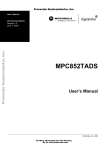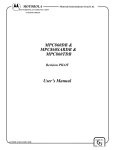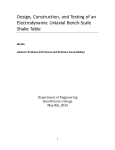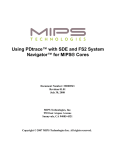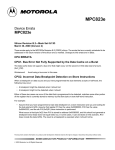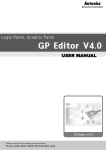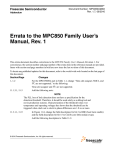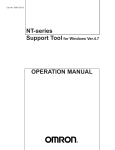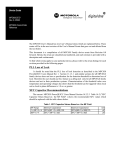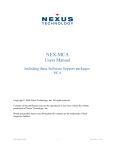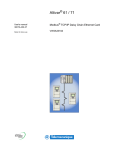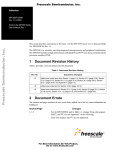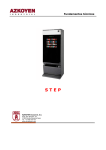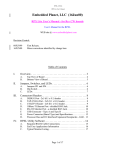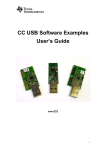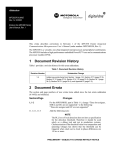Download RPX Lite (RPXL_CW), Programmer`s Firmware Manual
Transcript
rpxl_fw_cw_basic.fm Programmer’s/FW Manual Proprietary and Confidential - All Rights Reserved - 1998, 1999, 2000 Embedded Planet, LLC (3Jan00) RPX Lite Programmer’s/FW Manual - For Rev CW boards Programming and FW Requirements for the RPXL This document contains confidential information and is intended for the sole purpose of the end user to develop applications on the RPX Lite product offered by Embedded Planet. Neither the document, nor reproductions of it, nor information derived from it is to be given to others, nor used for any other purpose other than for RPX Lite applications. No use is to be made of it which is or may be injurious to Embedded Planet and no use is to be made of it other than for RPX Lite applications. Revision Control: 15SEP99 First Release. Table of Contents I. Overview . . . . . . . . . . . . . . . . . . . . . . . . . . . . . . . . . . . . . . . . . . 4 II. Chip Select Mapping . . . . . . . . . . . . . . . . . . . . . . . . . . . . . . . . . 5 III. BSP Code Location . . . . . . . . . . . . . . . . . . . . . . . . . . . . . . . . . . 6 IV. Board Status and Control Registers (BSCRs) . . . . . . . . . . . . . . 8 V. I2C Devices/Addressing . . . . . . . . . . . . . . . . . . . . . . . . . . . . . 11 A. B. C. D. E. VI. SEP Format/Interface Structure . . . . . . . . . . . . . . . . . . . . . . . . . . 11 STTM Format/Interface Structure . . . . . . . . . . . . . . . . . . . . . . . . 12 System Integration Timers . . . . . . . . . . . . . . . . . . . . . . . . . . . . . . 13 PCMCIA Control Registers . . . . . . . . . . . . . . . . . . . . . . . . . . . . . 13 Option Register Mask Table . . . . . . . . . . . . . . . . . . . . . . . . . . . . . 14 Interrupt Structure . . . . . . . . . . . . . . . . . . . . . . . . . . . . . . . . . . 15 VII. Processor Pin Assignments . . . . . . . . . . . . . . . . . . . . . . . . . . . 16 A. B. C. Bus Interface Pins . . . . . . . . . . . . . . . . . . . . . . . . . . . . . . . . . . . . . 16 PCMCIA Interface Pins . . . . . . . . . . . . . . . . . . . . . . . . . . . . . . . . 17 I/O Port Interface Pins . . . . . . . . . . . . . . . . . . . . . . . . . . . . . . . . . 18 VIII. Performance . . . . . . . . . . . . . . . . . . . . . . . . . . . . . . . . . . . . . . . 19 A. B. @ 20 or 25MHZ . . . . . . . . . . . . . . . . . . . . . . . . . . . . . . . . . . . . . . 19 @ 33MHZ . . . . . . . . . . . . . . . . . . . . . . . . . . . . . . . . . . . . . . . . . . . 19 Page 1 of 20 rpxl_fw_cw_basic.fm Programmer’s/FW Manual Proprietary and Confidential - All Rights Reserved - 1998, 1999, 2000 C. D. E. F. @ 40MHZ . . . . . . . . . . . . . . . . . . . . . . . . . . . . . . . . . . . . . . . . . . . 19 @ 50MHZ . . . . . . . . . . . . . . . . . . . . . . . . . . . . . . . . . . . . . . . . . . . 19 @ 66MHZ . . . . . . . . . . . . . . . . . . . . . . . . . . . . . . . . . . . . . . . . . . . 20 @ 81MHZ . . . . . . . . . . . . . . . . . . . . . . . . . . . . . . . . . . . . . . . . . . . 20 Page 2 of 20 rpxl_fw_cw_basic.fm Programmer’s/FW Manual Proprietary and Confidential - All Rights Reserved - 1998, 1999, 2000 List of Tables Overview of FW Related Functions . . . . . . . . . . . . . . . . . . . . . . . . . . . . . . . . . . . 4 Chip Select Mapping . . . . . . . . . . . . . . . . . . . . . . . . . . . . . . . . . . . . . . . . . . . . . . . 5 Code Location in x32 FLASH . . . . . . . . . . . . . . . . . . . . . . . . . . . . . . . . . . . . . . . . 6 BCSR0 . . . . . . . . . . . . . . . . . . . . . . . . . . . . . . . . . . . . . . . . . . . . . . . . . . . . . . . . . . 8 BCSR1 . . . . . . . . . . . . . . . . . . . . . . . . . . . . . . . . . . . . . . . . . . . . . . . . . . . . . . . . . . 9 BCSR2 . . . . . . . . . . . . . . . . . . . . . . . . . . . . . . . . . . . . . . . . . . . . . . . . . . . . . . . . . 10 BCSR3 . . . . . . . . . . . . . . . . . . . . . . . . . . . . . . . . . . . . . . . . . . . . . . . . . . . . . . . . . 10 I2C Address Map . . . . . . . . . . . . . . . . . . . . . . . . . . . . . . . . . . . . . . . . . . . . . . . . . 11 TBSCR, RTCSC, and PISCR . . . . . . . . . . . . . . . . . . . . . . . . . . . . . . . . . . . . . . . 13 PGCRA and PGCRB . . . . . . . . . . . . . . . . . . . . . . . . . . . . . . . . . . . . . . . . . . . . . . 13 OR Mask . . . . . . . . . . . . . . . . . . . . . . . . . . . . . . . . . . . . . . . . . . . . . . . . . . . . . . . 14 Interrupt Structure for the RPX Lite . . . . . . . . . . . . . . . . . . . . . . . . . . . . . . . . . . 15 Bus Interface - Multiple Function Pins . . . . . . . . . . . . . . . . . . . . . . . . . . . . . . . . 16 PCMCIA - Multiple Function Pins . . . . . . . . . . . . . . . . . . . . . . . . . . . . . . . . . . . 17 Page 3 of 20 rpxl_fw_cw_basic.fm Programmer’s/FW Manual Proprietary and Confidential - All Rights Reserved - 1998, 1999, 2000 I. Overview The RPX Lite is a highly integrated SBC based on the Motorola MPC850 and MPC823. The MPC850 versions are targeted for the tel-com industries, while the MPC823 version is targeted for the industrial controls market. Support is available for several commonly used RTOSs. The functions included on the RPX Lite that are related to FW are listed as follows: Table 1: Overview of FW Related Functions Entity Function Processor DRAM FLASH NVRAM 10Base-T Ethernet Monitor Port Serial EEPROM Serial Temp & Thermal Monitor BCSR MPC850 (SR, DC, DH, etc.) or MPC823 4MB or 16MB 2MB, 4MB, 8MB, or 16MB 0KB, 32KB, 128KB, 512KB SCC2 SMC1 I2C I2C BCSR0, 1, 2, and 3 The PCMCIA Port and the USB Port are supported in hardware, but it is the responsibility of the end user to develop the driver/application required for any given PCMCIA card or USB peripheral. Support for some PCMCIA Cards, such as ATA, will occur at a later date. A future release of the RPX Utility Program will support testing of the PCMCIA and USB hardware. Expansion Boards will be supported as they are designed (T1/E1, xDSL, Video, etc.) For Hardware Setup information, see the RPX Lite User’s Manual Page 4 of 20 rpxl_fw_cw_basic.fm Programmer’s/FW Manual Proprietary and Confidential - All Rights Reserved - 1998, 1999, 2000 II. Chip Select Mapping Table 2: Chip Select Mapping Chip Select Number Port Size Function/ Address CS0# x32 FLASH (x32) Comment Reset Vector @ IP = ‘0’: FFF0 0000 FE00 DRAM (x32) Vector set at IP = ‘0’ in hardware BR0 set at FE00 4 or 16MBytes CS2# 0000 Expansion Header Routed to Expansion Receptacle CS3# x32 UUUU Control & Status Registers CS4# x8 FA40 NVRAM or SRAM CS1# x32 FA00 Expansion Header CS5# CS6# x16 or U CS7# x16 or U IMMR x32 UUUU PCMCIA Slot B Chip Select Even Bytes or Chip Select 6 to I/O Header UUUU PCMCIA Slot B Chip Select Odd Bytes or Chip Select 7 to I/O Header UUUU Value at reset = FF00 0000, then set to FA20 0000 Byte and/or word accessible. 0K, 32K, 128K, or 512KBytes Also available at Expansion Receptacle Routed to Expansion Receptacle 1) OP2 in MPC850 PCMCIA Control Register selects mode: L = PCMCIA Slot B enabled H = CS6# to Expansion Header Enabled 1) OP2 in MPC850 PCMCIA Control Register selects mode: L = PCMCIA Slot B enabled H = CS7# to I/O Expansion Header Enabled Address maps are recommended values for the RPX Lite, but other mappings can be utilized for any given application. U = User or Application Defined Page 5 of 20 rpxl_fw_cw_basic.fm Programmer’s/FW Manual Proprietary and Confidential - All Rights Reserved - 1998, 1999, 2000 III. BSP Code Location At start-up, the code for the RPX Lite is always located in the second to highest 512K block of memory. This 512K block of memory is reserved for the BSP or RTOS (FLASH intensive RTOSs will require a larger block of memory). Table 3: Code Location in x32 FLASH FLASH Memory Option Address Range Block Size 2MByte 29LV400 4MBytes 29LV800 8MBytes 29LV160 16MBytes 29LV320 FFFF FFFF - FFF8 0000 512KB 512KB 512KB 512KB 512KB 512KB 512KB 512KB 512KB 512KB 512KB 512KB 512KB 512KB 512KB 512KB 512KB 512KB 512KB 512KB 512KB 512KB 512KB 512KB 512KB 512KB 512KB 512KB 512KB 512KB 512KB 512KB User BSP User BSP User BSP User BSP FFF7 FFFF - FFF0 0000 FFEF FFFF - FFE8 0000 FFE7 FFFF - FFE0 0000 FFDF FFFF - FFD8 0000 FFD7 FFFF - FFD0 0000 FFCF FFFF - FFC8 0000 FFC7 FFFF - FFC0 0000 FFBF FFFF - FFB8 0000 FFB7 FFFF - FFB0 0000 FFAF FFFF - FFA8 0000 FFA7 FFFF - FFA0 0000 FF9F FFFF - FF98 0000 FF97 FFFF - FF90 0000 FF8F FFFF - FF88 0000 FF87 FFFF - FF80 0000 FF7F FFFF - FF78 0000 FF77 FFFF - FF70 0000 FF6F FFFF - FF68 0000 FF67 FFFF - FF60 0000 FF5F FFFF - FF58 0000 FF57 FFFF - FF50 0000 FF4F FFFF - FF48 0000 FF47 FFFF - FF40 0000 FF3F FFFF - FF38 0000 FF37 FFFF - FF30 0000 FF2F FFFF - FF28 0000 FF27 FFFF - FF20 0000 FF1F FFFF - FF18 0000 FF17 FFFF - FF10 0000 FF0F FFFF - FF08 0000 FF07 FFFF - FF00 0000 Page 6 of 20 rpxl_fw_cw_basic.fm Programmer’s/FW Manual Proprietary and Confidential - All Rights Reserved - 1998, 1999, 2000 1) Reset vector @ FFF0 0100 but for A[0:3 4:7 8:11]: A(0:10) = X for 2MBytes A(0:9) = X for 4MBytes A(0:8) = X for 8MBytes A(0:7) = X for 16MBytes where X = “don’t’ care” (i.e. the address lines defined by “X” are not connected to the FLASH memory) 2) The actual on-board FLASH memory size is mirrored throughout the entire address space (excluding internal processor address spaces) until OR0 is written. 3) Flash base address is remapped to FE00 0000 when BR0/OR0 is written. Page 7 of 20 rpxl_fw_cw_basic.fm Programmer’s/FW Manual Proprietary and Confidential - All Rights Reserved - 1998, 1999, 2000 IV. Board Status and Control Registers (BSCRs) There exists on-board control and status registers. These registers are configured as a x32 port and can be accessed via byte, word, or longword. The registers are defined as shown in the Table below. All registers are read modify write capable (except register 3 which is read only). Upon power-up (HRESET#) the default value configured in the registers, after masking (“anding”) with FF 1F F8 FF, is longword 3E 00 80 UU (i.e. if the first access to the BCSR after reset is a longword read, the value read, after masking with FF 1F F8 FF will be 3E 00 80 UU, where UU is as defined below). Register values at reset (values in binary and “x” = undefined or determined by function): R/W Register 0 = 0011 1110 R/W Register 1 = xxx0 0000 R/W Register 2 = 1000 0xxx RO Register 3 = xxxx 11xx (UU = first four bits = dipswitch setting, 1, 1, NVRAM Battery status, RTC Battery Status) Table 4: BCSR0 Register Number Byte Address Function Ethernet XCVR Control Bit Mnemonic 0 ETHEN 1 ETHLPBK 2 COLTEST# 3 FULLDPLX# 4 5 LED4 LED5 0 R/W reset value = 0011 1110 FA40 0000 LEDS CS4# Control 6 ENNVRAM Monitor XVCR Control 7 ENMONXCVR Page 8 of 20 Definition 0 = Disable Transceiver 1 = Enable Transceiver 0 = Disable Transceiver Loop Back Test 1 = Enable Transceiver Loop Back Test 0 = Enable collision testing on Transceiver 1 = Disable collision testing on Transceiver 0 = Enable full duplex mode of operation 1 = Disable full duplex mode of operation 0 = LED “on” 1 = LED “off” 0 = Disable on-board NVRAM and Enable CS4# at I/O Receptacle 1 = Enable on-board NVRAM and Disable CS4# at I/O Receptacle 0 = Disable Monitor Port Transceiver 1 = Enable Monitor Port Transceiver rpxl_fw_cw_basic.fm Programmer’s/FW Manual Proprietary and Confidential - All Rights Reserved - 1998, 1999, 2000 Table 5: BCSR1 Register Number Byte Address Function Bit Unused 8 9 10 Mnemonic Definition Unused 11 IPB5SEL 12 PCVCTL4 0 = BVD2/SPKR signal routed to IPB5 1 = INPACK#/DREQ signal routed to IPB5 Defines VCC_SLOT voltage on PCMCIA Slot B: GND +5.0V +3.3V GND 0 0 1 1 0 1 0 1 1 R/W reset value = xxx0 0000 FA40 0001 13 PCVCTL5 PC Slot B Control Defines VPP_SLOT voltage on PCMCIA Slot B: 14 PCVCTL6 GND 0 0 15 PCVCTL7 Page 9 of 20 Note 1 Note 2 0 1 1 0 HI-Z 1 1 Note 1: Hi-Z if VCC_SLOT = GND, else +12.0V. Note 2: Hi-Z if VCC_SLOT = GND, else VCC_SLOT Voltage rpxl_fw_cw_basic.fm Programmer’s/FW Manual Proprietary and Confidential - All Rights Reserved - 1998, 1999, 2000 Table 6: BCSR2 Register Number Byte Address Function Bit Mnemonic 16 USBSUSP 17 USBSPD 18 USBPWREN 19 ENUSBCLK 20 ENPA5HDR 2 R/W reset value = 1000 0xxx USB Control FA40 0002 Unused 21 22 23 Definition 0 = Enable USB Transceiver 1 = Disable USB Transceiver 0 = Low Speed (6MHZ USB clock) 1 = High Speed (48MHZ USB clock) 0 = Disable +5.0V power to USB connector 1 = Enable +5.0V power to USB connector - do not enable if 3V power option is used 0 = Disable USB clock to PA5 1 = Enable USB clock to PA5 0 = Disable PA5 at P2 Receptacle 1 = Enable PA5 at P2 Receptacle Unused Note: - The USB clock can be fed to both PA5 and the P2 Receptacle. - The USB clock is currently set for 6MHZ and 48MHZ. Via special, this “USB Clock” can be set to any realizable frequency as provided for by the on-board CY2071A clock synthesizer. Table 7: BCSR3 Register Number Byte Address Function Bit Mnemonic 24 25 26 27 28 D24 D25 D26 D27 RPXL Flash 29 RDY/BSY# Nvram 30 BWNVR# RTC 31 BWRTC# SW 3 R only W = xx reset value = xxxx 11xx FA40 0003 Page 10 of 20 Definition D(2427) defines DipSwitch Settings (D24 is MSb, D27 is LSb) (D24 = position 0 on switch) Reserved (reads back ‘1’) 0 = Flash operation executing and busy 1 = Flash operation complete 0 = NVRAM Battery is low 1 = NVRAM Battery is good or no NVRAM installed 0 = Real Time Clock Battery is low or no External Battery is attached 1 = Real Time Clock Battery is good rpxl_fw_cw_basic.fm Programmer’s/FW Manual Proprietary and Confidential - All Rights Reserved - 1998, 1999, 2000 V. I2C Devices/Addressing The board contains two devices on the I2C bus. These two devices are a Serial EEPROM (SEP) and a Serial Temperature & Thermal Monitor (STTM). The I2C bus also routes to the Expansion Header for possible use on Expansion board designs. The I2C interface pin SDA from the processor must be programmed as open drain. The I2C interface pin SCL from the processor does not necessarily have to be programmed as an open drain signal, because presently there are no other master I2C devices that reside on the I2C bus. If a master I2C device where designed onto an expansion card, then the SCL signal must also be programmed for open drain operation. The RPX Lite board sets both I2C signals to open drain operation. Table 8: I2C Address Map Device Function I2C Addressing SEP Configuration Information STTM Serial Temperature and Thermal Monitor A8h - A9h for 1K/2K devices (128/256 x 8) A8h - ABh for 4K device (512 x 8) A8h - AFh for 8K device (1K x 8) 90h - 91h (8 bytes in device) A. SEP Format/Interface Structure Data is stored in the EEPROM device as a series of ASCII records. Each record is terminated with the NEWLINE character (ASCII hex 0x0A), and the last record is terminated with two NEWLINE characters. All data bytes after the double NEWLINE of the last record have the binary value 0xFF. Each record consists of a name and a value which are separated by an ‘=’ character. A name identifies the meaning of the value which follows it. For example, the record HZ=50 declares the system frequency (in MHZ) to be 50. For more information on the names used in records, please read the section or appendix on EEPROM data formats in the RPX Utility Software Manual. Page 11 of 20 rpxl_fw_cw_basic.fm Programmer’s/FW Manual Proprietary and Confidential - All Rights Reserved - 1998, 1999, 2000 B. STTM Format/Interface Structure The driver for the STTM sets the interrupt out for low true operation. Interrupt mode is selected but is not enabled at the processor (IRQ1#). The driver returns the temperature of the device and also a calibrated temperature for reporting ambient air temperature. The calibration parameter is programmed into the SEP and is used to extrapolate ambient air temperature. Page 12 of 20 rpxl_fw_cw_basic.fm Programmer’s/FW Manual Proprietary and Confidential - All Rights Reserved - 1998, 1999, 2000 C. System Integration Timers Table 9: TBSCR, RTCSC, and PISCR Mnemonic Internal Address TBSCR 200 RTCSC 220 PISCR 240 Note: Value = Bits 0-15 Default Value VVC3 00C3 VVC1 00C1 VV83 0083 Function VV = User Specified Interrupt Level Time Base and Decrementer Enabled but Stopped on FRZ VV = User Specified Interrupt Level RTC Enabled but not stopped on FRZ VV = User Specified Interrupt Level Periodic Timer Enabled, but Stopped on FRZ and Periodic Timer Interrupt Disable These registers powered by the KAPWR pin (Battery Backed Circuits). They will only be reset on POR (when battery voltage is not available or applied for the first time, and the system powers up). The RPX Lite requires an external battery for back-up operation. D. PCMCIA Control Registers PCMCIA port A is not implemented on the MPC823 or MPC850 family. Table 10: PGCRA and PGCRB Mnemonic Internal Address PGCRA PGCRB 0E0 0E4 Note: Value - Bits 0-15 Default Value Function Reserved - not implemented in the MPC850/MPC823 VVLL 0080 VV = User Specified Interrupt Level for PCMCIA Card LL = User Specified Interrupt Level for Status Change 0000 0080 Internal DMA request disabled Buffers for Card B disabled ( OP2 deasserted) and CS6#/CS7# valid at I/O Header Reset signal active (OP3 asserted) OP2 in PGCRB has a dual function in that it either enables the buffers for PCMCIA Slot B or enables the buffers which allow the CS6# and CS7# signals to be active at the I/O Header: (If Bit 24 = CBOE = 0 then PCMCIA Slot B Buffers Enabled and CS6#/CS7# not active at I/O Header) (If Bit 24 = CBOE = 1 then PCMCIA Slot B Buffers Disabled and CS6#/CS7# active at I/O Header) Page 13 of 20 rpxl_fw_cw_basic.fm Programmer’s/FW Manual Proprietary and Confidential - All Rights Reserved - 1998, 1999, 2000 E. Option Register Mask Table Table 11: OR Mask A(0:12) in OR’s “mmmm m” in Table above F800 0 FC00 0 FE00 0 FF00 0 FF80 0 FFC0 0 FFE0 0 FFF0 0 FFF8 0 FFFC 0 FFFE 0 FFFF 0 FFFF 8 128MBytes 64MBytes 32MBytes 16MBytes 8MBytes 4MBytes 2MBytes 1MByte 512KBytes 256KBytes 128KBytes 64KBytes 32KBytes Page 14 of 20 rpxl_fw_cw_basic.fm Programmer’s/FW Manual Proprietary and Confidential - All Rights Reserved - 1998, 1999, 2000 VI. Interrupt Structure Table 12: Interrupt Structure for the RPX Lite Entity External Interrupt Interrupt Code IRQ0# IRQ1# IRQ2# IRQ3# 00 08 10 18 IRQ4# 20 IRQ5# 28 IRQ6# 30 IRQ7# 38 NMI Internal Level 0 Level 1 Level 2 Level 3 Level 4 Level 5 Level 6 Level 7 SIU DEC TB PIT RTC PCMCIA CPM Port C Pins SCC(1:4) Timer(1:4) DMA RISC Timer I2C SPI SMC1 SMC2 USB Function Power Fail Temperature and Thermal Monitor (STTM) Availability depends on configuration - On I/O Header (pin multiplexes IRQ3# with DPAR0) Availability depends on configuration - On I/O Header (pin multiplexes IRQ4# with DPAR1) Availability depends on configuration - On I/O Header (pin multiplexes IRQ5# with DPAR2) Availability depends on configuration - On I/O Header (pin multiplexes IRQ6# with DPAR3) From Header From Watchdog Timer or IRQ0# 04 0C 14 1C 24 2C 34 3C Routing from interrupt sources below. Actual routings depended on application Each source is software routed to any “Level” (Each source has unique “vector”) 32 sources combined into one interrupt which is software routed to any “Level” (Each source has unique “vector”) Page 15 of 20 rpxl_fw_cw_basic.fm Programmer’s/FW Manual Proprietary and Confidential - All Rights Reserved - 1998, 1999, 2000 VII. Processor Pin Assignments The following sections define the function that is associated with certain processor pins. Many of the processor pins have multiple functions, most of which are programmable by the FW. This section will detail the functionality associated with the respective processor pins, and must be used by the firmware/software to correctly configure the system. A. Bus Interface Pins Table 13: Bus Interface - Multiple Function Pins Defined Function SIZ0/REG# BDIP/GPLB51 SIZ0 and REG# BDIP# Unused Y Y RSV#/IRQ2#1 IRQ2# Unused Y KR#/RETRY#/IRQ4#/SPKROUT1 RETRY# Unused Y IRQ(3:6)# Can be redefined for DP(0:3) for an Expansion Card that requires Parity. Use IRQ7# or one of the Port C pins for interrupt capability Y DP0/IRQ3#1 DP1/IRQ4#1 DP2/IRQ5#1 DP3/IRQ6#1 FRZ/IRQ6#1 CS6#/CE1B# CS7#/CE2B# GPLA0# GPLA1# FRZ CS6# or CE1B# CS7# or CE2B# GPLA2#/CS2#1 GPLA3# GPLA2# N See OP2 below See OP2 below UPM Output Enable GPCM Output Enable Only used at I/O Expansion Socket Y Y Y Y Y 2 UPWAITA Unused Unused, Pulled-Down Y N UPWAITB/GPLB4#2 GPLA5# UPWAITB Unused, Pulled-Down N ALEB/DSCK/AT13 ALEB Unused PCMCIA Slot B ALE signal Y N OP2/MODCK1/STS#3 OP2 N OP3/MODCK2/DSDO3 OP3 PCMCIA Slot B Buffer Enable 0 = Enable Buffers, Disable CS6#/CS7# at I/O Header 1 = Disable Buffers, Enable CS6#/CS7# at I/O Header (MODCK1 @ reset rising = ‘0’) PCMCIA Slot B Reset Signal (MODCK2 @ reset rising = ‘0’) UPWAITA/GPLA4# 1 Programmed 2 Programmed 3 Hard Additional comments At Expansion Socket Processor Pin Name in SIUMCR in MAMR Reset Configuration and SIUMCR Page 16 of 20 N rpxl_fw_cw_basic.fm Programmer’s/FW Manual Proprietary and Confidential - All Rights Reserved - 1998, 1999, 2000 B. PCMCIA Interface Pins The hard reset word configures the following pins to function as PCMCIA signals. Table 14: PCMCIA - Multiple Function Pins Processor Pin Name PCMCIA Function IPB0 IPB1 IPB2 IPB3 IPB4 IPB5 VS1 VS2 WP or IOCS16# or DREQ# CD2 CD1 BVD1 or SPKR or DREQ# IPB6 IPB7 WAITB# OP3 OP2 BVD2 or STSCHG RDY or IRQ# Wait States Reset Signal Buffer Enable/Disable Control Additional comments At Expansion Socket Function depends on memory or I/O Card Function depends on memory or I/O Card (see Note 1) Function depends on memory or I/O Card Function depends on memory or I/O Card No Used to enable or disable the on-board buffers that isolate the PCMCIA bus from the Processor bus. & CS6#/CS7# Enable/Disable Control In addition, this signal also enables or disables chip selects 6 and 7 from the I/O Header. When the Buffers are enabled, CS6# and CS7# are disabled. When the Buffers are disabled, CS6# and CS7# are enabled. Note 1: The PCMCIA signal INPACK# is not required by the MPC8XX, and as such, not supported. Some PCMCIA type DMA cards route the DREQ signal on the INPACK# pin. To support these cards, Control Register 2, bit 19, allows routing of the INPACK# (DREQ) signal to IPB5. Note 2: BCSR1, bits 12-15, also controls the operation of the PCMCIA interface (voltages to socket). Page 17 of 20 rpxl_fw_cw_basic.fm Programmer’s/FW Manual Proprietary and Confidential - All Rights Reserved - 1998, 1999, 2000 C. I/O Port Interface Pins Refer to the pinouts document for pinout assignments. 3) Any of the port signals that are used for on-board functions can be used on an Expansion Card if the respective on-board function is disabled (via the BCSRs). 4) Port C pins can also be defined as interrupt signals to the processor core. Each Port C pin that is configured as an interrupt pin has a unique vector associated with it, and each pin can be defined as edge or low level active. This allows Expansion Cards to use Port C pins as interrupt lines to the processor if needed. Check the P1_P2.xls spreadsheet for available Port C pins and also see note 3) above. 5) The I2C bus (PB26 and PB27 pins) is used on-board but also routed to the I/O Header. See the I2C section above for used I2C addresses. Page 18 of 20 rpxl_fw_cw_basic.fm Programmer’s/FW Manual Proprietary and Confidential - All Rights Reserved - 1998, 1999, 2000 VIII. Performance See “Clocks and Reset Registers” section for the exact frequency that processor is running at. A. @ 20 or 25MHZ Single Beat Read 3 clocks (1 wait states) Single Beat Write 2 clocks (0 wait states) Burst Read 7 clocks (1:1:2:1 cycle) Burst Write 5 clocks (0:1:1:1 cycle) Refresh 2 clocks Back to Back Accesses, including refresh, have 1 clock between accesses B. @ 33MHZ Single Beat Read 3 clocks (1 wait states) Single Beat Write 3 clocks (1 wait states) Burst Read 9 clocks (1:2:2:2 cycle) Burst Write 5 clocks (0:1:1:1 cycle) Refresh 3 clocks Back to Back Accesses, including refresh, have 1 clock between accesses C. @ 40MHZ Single Beat Read 4 clocks (2 wait states) Single Beat Write 4 clocks (2 wait states) Burst Read 10 clocks (2:2:2:2 cycle) Burst Write 10 clocks (2:2:2:2 cycle) Refresh 4 clocks Back to Back Accesses, including refresh, have 1 clock between accesses D. @ 50MHZ Single Beat Read 5 clocks (3 wait states) Single Beat Write 5 clocks (3 wait states) Burst Read 11 clocks (3:2:2:2 cycle) Burst Write 10 clocks (3:2:2:1 cycle) Refresh 5 clocks Back to Back Accesses, including refresh, have 1 clock between accesses Page 19 of 20 rpxl_fw_cw_basic.fm Programmer’s/FW Manual Proprietary and Confidential - All Rights Reserved - 1998, 1999, 2000 E. @ 66MHZ Single Beat Read 6 clocks (2 wait states) Single Beat Write 6 clocks (2 wait states) Burst Read 18 clocks (2:4:4:4 cycle) Burst Write 10 clocks (1:2:2:2 cycle) Refresh 6 clocks Back to Back Accesses, including refresh, have 2 clocks between accesses F. @ 81MHZ Single Beat Read 8 clocks (4 wait states) Single Beat Write 8 clocks (4 wait states) Burst Read 20 clocks (4:4:4:4 cycle) Burst Write 20 clocks (4:4:4:4 cycle) Refresh 8 clocks Back to Back Accesses, including refresh, have 2 clocks between accesses Page 20 of 20




















